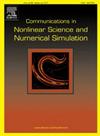Effects of Volterra's formulation of heredity on vibrations in harmonic and Duffing oscillators
IF 3.4
2区 数学
Q1 MATHEMATICS, APPLIED
Communications in Nonlinear Science and Numerical Simulation
Pub Date : 2025-03-25
DOI:10.1016/j.cnsns.2025.108799
引用次数: 0
Abstract
In recent years, the effects of heredity on dynamical systems have been analysed using the fractional derivative. But, another way of considering the heredity is the integral formulation
proposed by Vito Volterra in 1912 and later almost forgotten. It can also be termed as long duration feedback. This paper presents some of the results of this formulation of the heredity on the dynamics of a linear harmonic oscillator and on that of the Duffing oscillator which are representatives of oscillating mechanical structures. For the linear oscillator, the heredity amplifies the vibration amplitude and shifts the resonance frequency to higher values. For the hereditary hardening Duffing oscillator, the analysis of the stability of the single equilibrium point reveals the existence of a Hopf bifurcation appearing at a given value of the heredity coefficient. This leads to self-sustained oscillations which are determined mathematically using the averaging method and confirmed numerically. The heredity also modifies the length of the hysteresis domain through the change of the effective stiffness and damping coefficients. It can also be a source of chaos in a system free of chaos which can appear through quasiperiodic routes and period-doubling. For the hereditary Duffing oscillator with single hump and double well potential or the bistable Duffing oscillator with three equilibrium points, one also finds the existence of a Hopf bifurcation appearing at a given value of the heredity coefficient. The hereditary bistable Duffing oscillator unveils monostable and bistable periodic characteristics, period doubling to monostable and bistable chaos and coexistence between chaotic and periodic characteristics.
Volterra的遗传公式对谐波和Duffing振子振动的影响
近年来,人们利用分数阶导数分析了遗传对动力系统的影响。但是,另一种考虑遗传的方法是维托·沃尔泰拉在1912年提出的积分公式,后来几乎被遗忘了。它也可以被称为长时间反馈。本文给出了作为振动机械结构代表的线性谐振子和杜芬振子动力学的遗传公式的一些结果。对于线性振荡器,遗传放大了振动幅度并将共振频率移至更高的值。对遗传硬化Duffing振子的单平衡点稳定性分析表明,在给定的遗传系数处存在Hopf分岔。这导致了用平均法在数学上确定并在数值上证实的自持续振荡。遗传还通过改变有效刚度系数和阻尼系数来改变滞回域的长度。它也可以是无混沌系统中的混沌源,这种混沌可以通过准周期路径和周期加倍出现。对于具有单驼峰和双阱势的遗传Duffing振子或具有三个平衡点的双稳态Duffing振子,我们还发现在给定的遗传系数处存在Hopf分岔。遗传双稳态Duffing振荡器揭示了单稳态和双稳态的周期特性,周期倍增到单稳态和双稳态混沌以及混沌与周期共存的特性。
本文章由计算机程序翻译,如有差异,请以英文原文为准。
求助全文
约1分钟内获得全文
求助全文
来源期刊

Communications in Nonlinear Science and Numerical Simulation
MATHEMATICS, APPLIED-MATHEMATICS, INTERDISCIPLINARY APPLICATIONS
CiteScore
6.80
自引率
7.70%
发文量
378
审稿时长
78 days
期刊介绍:
The journal publishes original research findings on experimental observation, mathematical modeling, theoretical analysis and numerical simulation, for more accurate description, better prediction or novel application, of nonlinear phenomena in science and engineering. It offers a venue for researchers to make rapid exchange of ideas and techniques in nonlinear science and complexity.
The submission of manuscripts with cross-disciplinary approaches in nonlinear science and complexity is particularly encouraged.
Topics of interest:
Nonlinear differential or delay equations, Lie group analysis and asymptotic methods, Discontinuous systems, Fractals, Fractional calculus and dynamics, Nonlinear effects in quantum mechanics, Nonlinear stochastic processes, Experimental nonlinear science, Time-series and signal analysis, Computational methods and simulations in nonlinear science and engineering, Control of dynamical systems, Synchronization, Lyapunov analysis, High-dimensional chaos and turbulence, Chaos in Hamiltonian systems, Integrable systems and solitons, Collective behavior in many-body systems, Biological physics and networks, Nonlinear mechanical systems, Complex systems and complexity.
No length limitation for contributions is set, but only concisely written manuscripts are published. Brief papers are published on the basis of Rapid Communications. Discussions of previously published papers are welcome.
 求助内容:
求助内容: 应助结果提醒方式:
应助结果提醒方式:


